Looking for the best siphon/vacuum coffee maker? Or let’s start with this: Have you ever even heard of vacuum coffee makers? Whether you’re new to the world of siphon coffee makers or a self-proclaimed veteran, one thing’s clear – these vacuum pots definitely look peculiar.
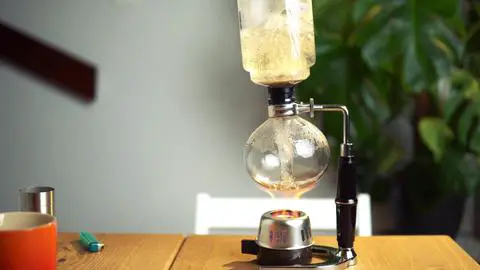
At first glance, a vacuum coffee maker is reminiscent of something straight from a chemistry lab – it takes the science of coffee making to a whole new level. This odd look might deter many coffee enthusiasts who may assume that the contraption is more complicated than its worth. However, those who persist will find a superbly fun coffee brewing method that offers quite a cup!
This comprehensive guide is designed as an overview of siphon coffee makers, how they work, some siphon coffee maker recommendations, and some steps for use. Read on for answers to these questions and more!
For your information, if you click on a product on Jayarrcoffee.com and decide to buy it, we may earn a small commission.
Table of Contents
The History of Siphon Coffee Makers
While siphon coffee makers may have experienced an uptick in popularity recently, they’re not nearly as new to coffee-making as you might initially assume. Really, these awesome brewing machines have been rediscovered.
According to historical records, the siphon coffee brewer was invented in the early 19th century by a gentleman known as Loeff of Berlin. While the brewing machine was his brainchild, its popularity is credited to a French woman, popularly known as Madame Vassieux. She commercialized her product and redesigned the original model into the double-balloon shape that characterizes the brew machine today.
Unsurprisingly, coffee aficionados around the world fell in love with the brewing technique and the quality of the resulting brew. By the 20th century, siphon coffee makers were a common item in many American homes, with companies such as Hario producing vacuum pots for the masses. The hype surrounding syphons gradually died off towards the turn of the 21st century as consumers sought more convenient and expedient brewing techniques. However, fast forward to the current day, siphon coffee makers are making a comeback as coffee enthusiasts and baristas are again devoting more time and energy to perfecting their cups.
How do Siphon Coffee Makers Work?
Get ready: It’s time to remember some of what you learned in your Chemistry and Physics classes. As you may have guessed from the name, siphon/vacuum coffee makers harness the power of atmospheric pressure to produce an incredibly fine brew.
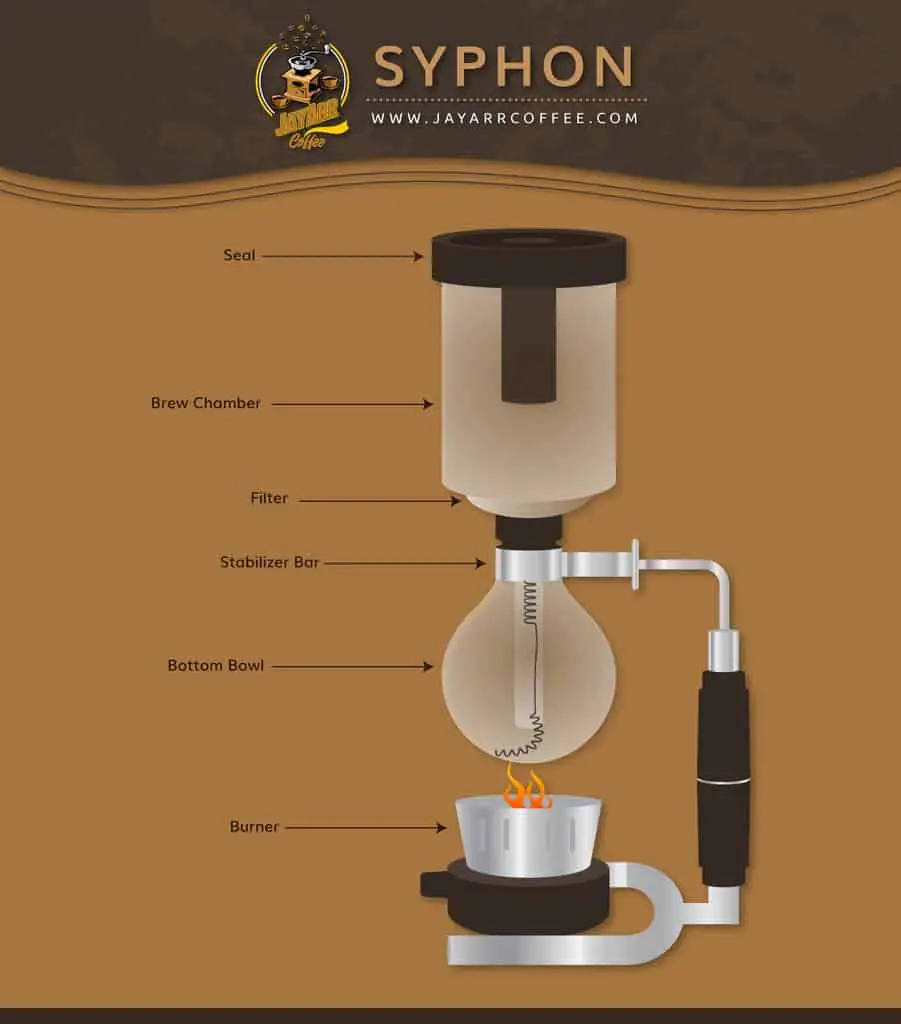
Below is a simplified step-by-step guide to what exactly goes on inside a vacuum coffee pot:
- First things first – the typical design consists of a constant heat source/burner, a filter, a siphon tube, and two glass chambers (arranged vertically). The lower chamber is filled with water.
- As you heat the bottom of the lower glass chamber, water boils releasing water vapor that causes an increase in pressure.
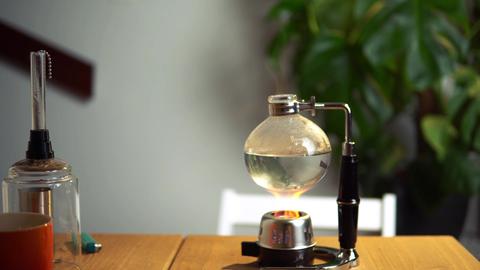
- After reaching a boil, the pressure inside the lower vessel is substantially greater than normal pressure and this pressure gradient forces the water upwards through the siphon and into the upper chamber.
- Coffee is then added to the water that moved into the upper chamber and mixed.
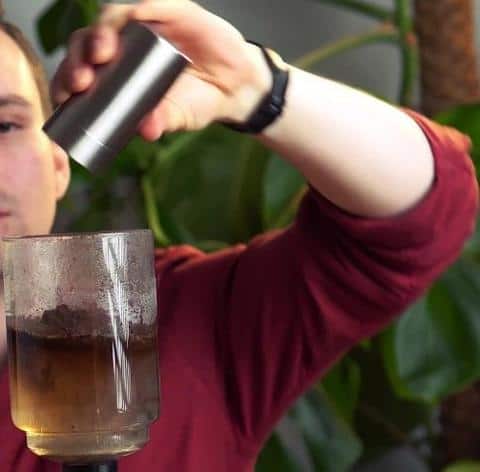
- After some time for brewing, the heat source is removed and the brewed coffee in the upper chamber drops back down through the tube due to gravity and a reversal of the pressure gradient between the two chambers (a partial vacuum).
- As the coffee falls back into the lower chamber, it passes through a filter/strainer, completing the brewing process.
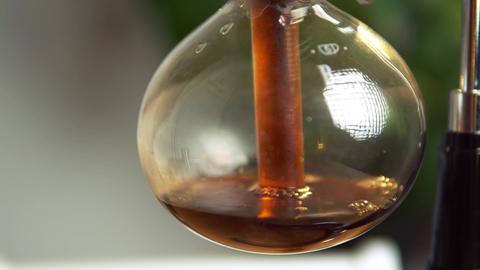
- In short, a siphon coffee maker combines some of the best aspects of filter brewing and full immersion brewing in one ingenious apparatus.
Why Choose a Vacuum Coffee Maker?
When it comes to brewing your favorite cup of Joe, you have several options at your disposal – French Press, Percolator, AeroPress Drip, etc. So why go out of your way to buy an odd-looking siphon coffee maker? Here are some advantages and disadvantages to consider:
Advantages of a Siphon Coffee Maker
- Full immersion of coffee grounds facilitates an even extraction. So, if you Stan single-origin coffees with complex tasting notes and flavor profiles, a siphon coffee maker is sure to get the best out of your grounds.
- Street Cred – If you want to thoroughly impress your coffee enthusiast friends, grace your dining room with one of these devices. It has that dramatic and exciting look that is sure to get people talking for weeks.
- Vacuum coffee makers are highly admired for their consistency, which is achieved by evenly heating water throughout the brewing process.
- Siphon coffee makers make awesome coffee! We’re talking about a smooth and pure cup of joe with minimal residue.
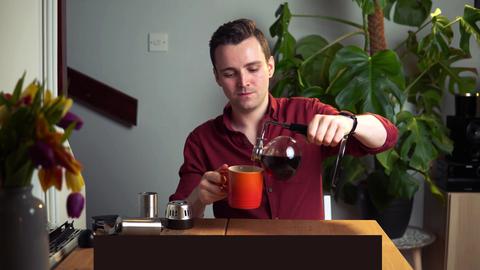
Disadvantages of a Siphon Coffee Maker
- Cleaning a siphon coffee maker isn’t super easy and requires some care.
- Vacuum coffee makers are rather delicate glassware and you might face challenges in storing them appropriately.
- Some of the parts might be costly and hard to find.
Features to Look for When Buying a Siphon Coffee Maker
Are you intrigued by the idea of siphon coffee makers? Looking to buy one of the brewing machines to impress your coffee circle or to just enjoy an awesome cup of coffee at home? If so, you’re well on your way to a wonderful experience. But, before you click “buy”- do you know what to look for? If not, don’t worry- we’ve tried to highlight some of the main features to pay attention to here to ensure you get what you are looking for.

- Stove-Top Vs. Standalone Electric: Basically, a standalone siphon coffee maker is pre-fitted with a burner (uses butane, gas, or alcohol) along with a stand. This variety is much flashier than the stovetops, which are specially designed to sit on your stove. PS: The quality of coffee is barely affected by the type of heating source.
- Capacity: How many coffee drinkers do you serve on average? Knowing your daily needs and the capacity of a coffee brewing machine is crucial- unless you’re comfortable running two separate brews. Most siphon coffee makers list their capacity in terms of cups.
- Filter: You’ll often have to choose between cloth and stainless-steel filters. While they both work wonderfully, the latter is easier to clean.
- Material: In any device, getting the materials right is half the battle. When it comes to siphon coffee makers, look for a model with heat-resistant glass and a stainless-steel stand. And if there are any plastic parts, ensure they are free of contaminants such as BPA.
- Design: The best vacuum coffee makers should have a functional yet aesthetically appealing design.
5 of The Best Siphon Coffee Makers
Now that you know what to look for in a siphon coffee maker, you can confidently get started on your shopping journey. But as you’ll soon find out, there are several options that may seem to fit the bill. How do you distinguish one from another?
Well, we asked ourselves the same question and decided to do the heavy lifting on your behalf. Below are some of the best siphon coffee makers with barista-worthy capabilities and eye-catching designs to help you concoct your brew like the genius you are!
NISPIRA Belgian Balance Luxury Siphon Coffee Maker – Most Elegant

Unique, classy, and a sight for sore eyes – the NISPIRA Belgian Balance vacuum brewer is perfect for anyone looking to impress. It’s designed as a refinement of early siphon coffee makers – it just looks the part, right from the gold/chrome body to the placement of the chambers. Unlike conventional siphon coffee makers, the two chambers of the NISPIRA Belgian are placed side-by-side rather than one on top of the other. Its gaudy design makes it fun to watch and will definitely impress your guests.
But it’s not just a pretty face. The NISPIRA features a stainless-steel retainer, high-quality heat resistant glass, a plug, measuring spoon/cup, balancing handle/shaft, and its own alcohol burner – making it a durable option. Unfortunately, the NISPIRA will set you back a few bucks in comparison to its competitors and the apparatus can be a bit hard to handle.
Bodum PEBO Stovetop Siphon Coffee Maker – Class in Simplicity

Looking for a clean, sleek, and simple vacuum coffee maker? Few products can match up to the versatility and simplicity of the Bodum PEBO stovetop. As a product of Scandinavia, it’s finely crafted to ensure top performance.. It features a flat borosilicate glass base (quite durable) that can be placed directly onto a heat source. And did we mention that it can prepare up to 8 cups in one brew?
If you’re into theatrics, then the Bodum PEBO might seem a bit bland for your taste. It’s also worth noting that the flimsy plastic handle can be a bit unstable – you’ll have to be careful while pouring your brew. There are also user reports that the rubber seal eventually wears off.
Hario Technica – Most Popular

This Japanese brewing machine appears to pop up in every conversation involving siphon coffee – and for good reason! The Hario Technica Standalone is just the right mix of price, simplicity, and efficiency – making it a favorite option amongst consumers. The classic design is easy to handle and clean, yet still aesthetically appealing. It produces up to 5 cups coffee to meet the needs of an average household in one brew.
A downside is the alcohol burner that comes with Hario Technica might make brewing a time-consuming process. You can buy a separate butane burner for faster heating, but it’ll make your total kit a bit more expensive. It also utilizes a cloth filter that is not easy to clean.
KitchenAid KCM08120B Electric Vacuum Coffee Maker – Best Electric

KitchenAid is a reputable brand – and they’ve outdone themselves again with the KitchenAid Electric siphon coffee maker. As it is an electric coffee maker, you don’t need a stove or flame. The KitchenAid KCM08120B boasts premium stainless steel and glass accents for a modern look and a quality brew.
KitchenAid goes a step further by including a magnetic locking seal between the chambers to minimize drain issues. It also features a large brewing capacity (8 cups). It comes with accessories such as a pack of cloth/steel filters, a scoop, and a cleaning brush. The only con of the KitchenAid Electric siphon coffee is the relatively high price tag.
YAMA Glass Stovetop – Best Value for Money

Strapped for cash but still want to experience siphon coffee? The YAMA Glass Stovetop siphon coffee maker might be your best bet. It offers endearing simplicity, a large 8-cup capacity, and brew quality comparable to its more expensive counterparts. The classic design also makes it easy to use and clean – including a handy heat-resistant handle and a wire diffuser for electric burners. And a lid that doubles as a stand to boot!
While you might have a hard time finding a product as good as YAMA’s Glass Stovetop in its price range, it’s not perfect. It’s made almost entirely of glass – making it relatively fragile. There are also reports of drain issues due to a less-than-perfect seal between the upper and lower chamber.
DIY Steps to Brew Coffee with a Siphon Coffee Maker
You’ve picked up the siphon coffee maker of your dreams – but how you go about actually preparing a cup of siphoned coffee? Here’s our “recipe” for an amazing cup of coffee:
Required Implements:
- Your favorite medium-finely ground coffee beans
- Siphon coffee maker
- A bamboo stir stick – a wooden or plastic spoon also serve the same purpose (metal spoons damage the glass)
- Scale
- Carafe
- Water
Instructions1. If you’re using a cloth filter, start by soaking it in warm water for a few minutes. This allows the filter to expand in order to completely cover the opening of the siphon.
2. Use the scale to measure the coffee grounds depending on your preferred profile.
3. Gently place the filter over the siphon opening. Position it from the upper vessel, ensuring you drop the attached chain to the bottom vessel (secures the filter).
4. Pour water into the bottom chamber and start the heating process. Some users prefer hot water (not boiling) as it speeds up the process.

5. Once the water begins to boil, place and seal the upper chamber on top of the lower chamber.
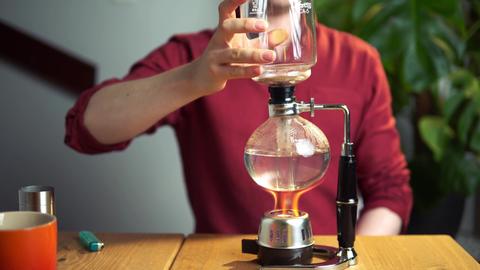
6. As the water continues to boil, the building pressure will force it into the upper chamber – a process commonly referred to as the “kick up.”
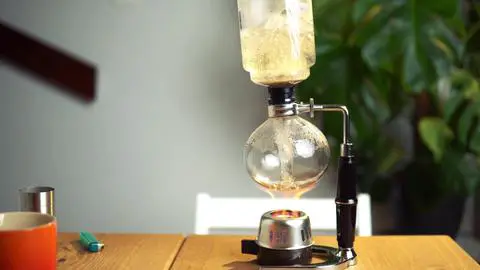
7. When around half the water has been pushed into the upper chamber, add your coffee grounds and quickly stir them with your bamboo stir stick.

8. Shut off the heat source after all the water has been pushed to the upper chamber and allow the coffee to steep. PS: The steep time often varies from one manufacturer to another – so check your user manual.
9. Break the seal and allow the liquid to gradually filter back into the bottom chamber – i.e., the “kick down.”

10. After the coffee has drained completely, pour it into a carafe, disconnect the chambers and clean the apparatus.
Now Get Brewing!
We understand that brewing a standout cup of Joe is both a science and an art – and a siphon coffee maker gives you just that. If you’re a barista or an enthusiastic coffee aficionado, this peculiar brewing apparatus/technique is definitely worth a try. Although brewing coffee with a siphon coffee maker is not as straightforward as with other brewing techniques, the reward is worth the effort.
